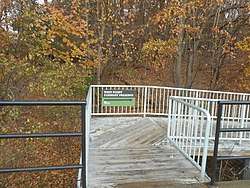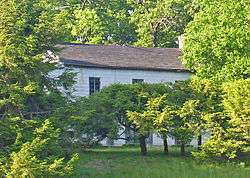West Point Foundry
|
West Point Foundry | |
_(14574929808).jpg) West Point Foundry, where the first American locomotive was built | |
  | |
| Location | Foundry Cove between NY 90 and NY Central RR tracks, Cold Spring, NY |
|---|---|
| Nearest city | Beacon |
| Coordinates | 41°24′51″N 73°57′22″W / 41.41417°N 73.95611°WCoordinates: 41°24′51″N 73°57′22″W / 41.41417°N 73.95611°W |
| Area | 93 acres (38 ha) |
| NRHP reference # | 73001250[1] |
| Added to NRHP | April 11, 1973 |
The West Point Foundry was an early ironworks in Cold Spring, New York, that operated from 1817 to 1911. Initiated after the War of 1812, it became most famous for its production of Parrott rifle artillery and other munitions during the Civil War, although it also manufactured a variety of iron products for civilian use. The increase of steel making and decreasing demand for cast iron after the Civil War caused it to become bankrupt gradually and cease operations during the early 20th Century.[2]
History
Founding and early products
The establishment of the foundry was encouraged by President James Madison, who, after the War of 1812, wanted to establish domestic foundries to produce artillery.[3] Cold Spring was an ideal site: timber for charcoal was abundant, there were many local iron mines, and the nearby Margaret's Brook provided water power to drive machinery. The site was guarded by West Point, across the Hudson River, and the river provided shipping for finished products.[3]
The West Point Foundry Association was incorporated by Gouverneur Kemble, who was of a merchant family in New York City (his mother's family had associations in Putnam County), and the foundry began operation during 1817.[3] Artillery was tested by shooting across the Hudson at the desolate slopes of Storm King Mountain (which would later have to be swept for unexploded ordnance as a result after some of it exploded during a 1999 fire).[4] The platform used for mounting artillery for proofing was uncovered during Superfund work in the early 1990s.[5] Besides artillery, the foundry also produced iron fittings for civilian uses, such as pipe for the New York City water system and sugar mills for shipment to the West Indies. A number of early locomotives were built at the foundry, including the Best Friend of Charleston (the first to be put into commercial service), the West Point (the third built for service in the United States), the DeWitt Clinton (the fourth, and first to operate in New York state), Phoenix, and Experiment.[3]
Parrott years and the Civil War
During 1835, Captain Robert Parker Parrott, a West Point graduate, was appointed inspector of ordnance from the foundry. The next year, he resigned his commission and on October 31, 1836, was appointed superintendent of the foundry. It prospered during his tenure, and was the site of numerous experiments with artillery and projectiles, culminating in his invention of the Parrott rifle cannon during 1860.[6] During 1843 the foundry also manufactured the USS Spencer, a revenue cutter which was the first iron ship built in the U.S.A..[3]
The foundry was busiest during the American Civil War due to military orders: at that time it had a workforce of 1,400 people and produced 2,000 cannon and three million shells.[3] Parrott also invented an incendiary shell which was used in an 8-inch Parrott rifle cannon (the "Swamp Angel") to bombard Charleston. The importance of the foundry for the war effort can be measured by the fact that President Abraham Lincoln visited and inspected it during June 1862.[7]
The fame of the foundry was such that Jules Verne, for his novel From the Earth to the Moon, chose it as the contractor for the Columbiad, a spaceship-launching cannon.[8]
Decline and demise
During 1867, Parrott resigned as superintendent, although he continued to experiment with artillery designs until his death during 1877.[9] Business of the foundry decreased due to competition from more modern techniques of iron and steel production. It had discontinued the use of charcoal and begun to purchase coal from Pennsylvania about 1870. However, it was unable to avoid receivership during 1884 and bankruptcy during 1889.[10] It was sold during 1897 to the Cornell brothers, makers of sugar mills, and ceased operation during 1911.[3]
Site archaeology
|
West Point Foundry Archeological Site | |
  | |
| Location | Address Restricted, Cold Spring, New York |
|---|---|
| Area | 100 acres (40 ha) |
| Built | 1817 |
| NRHP reference # | 10000059[1] |
| Added to NRHP | February 25, 2010 |


Of the buildings on the site, only the central office building remains intact; the remainder are in ruins. 87 acres (35 ha) around the site form a preserve owned by Scenic Hudson.[11] It can be visited by a short trail from the nearby Cold Spring Metro-North station. A major archaeological study of the site, funded by Scenic Hudson and performed by Michigan Tech, occurred from 2002-2008.[8] The West Point Foundry Archeological Site was listed on the National Register of Historic Places during 2010.[1]
See also
References
- 1 2 3 National Park Service (2010-07-09). "National Register Information System". National Register of Historic Places. National Park Service.
- ↑ "Cultural Resource Information System (CRIS)" (Searchable database). New York State Office of Parks, Recreation and Historic Preservation. Retrieved 2015-11-01. Note: This includes Lynn Beebe Weaver (November 1972). "National Register of Historic Places Registration Form: West Point Foundry" (PDF). Retrieved 2015-11-01. and Accompanying photographs
- 1 2 3 4 5 6 7 "History of West Point Foundry (archived)". Archived from the original on 2007-06-29. Retrieved 2006-12-14.
- ↑ "Corps of Engineers Cleanup Projects". Archived from the original on 2006-12-10. Retrieved 2006-12-14.
- ↑ "Foundry Cove Archaeology". Retrieved 2006-12-14.
- ↑ "Robert Parker Parrott". Archived from the original on March 30, 2006. Retrieved 2006-12-14.
- ↑ "Visit to West Point". Retrieved 2009-03-04.
- 1 2 "West Point Foundry Archaeology Project". Retrieved 2006-12-14.
- ↑ "A Village Born of Iron: Trouble in the Ravine". Archived from the original on June 5, 2009. Retrieved 2012-08-29.
- ↑ "A Village Born of Iron: A Long Road Ended". Archived from the original on October 16, 2006. Retrieved 2006-12-14.
- ↑ "West Point Foundry Preserve". Retrieved 2012-08-29.

